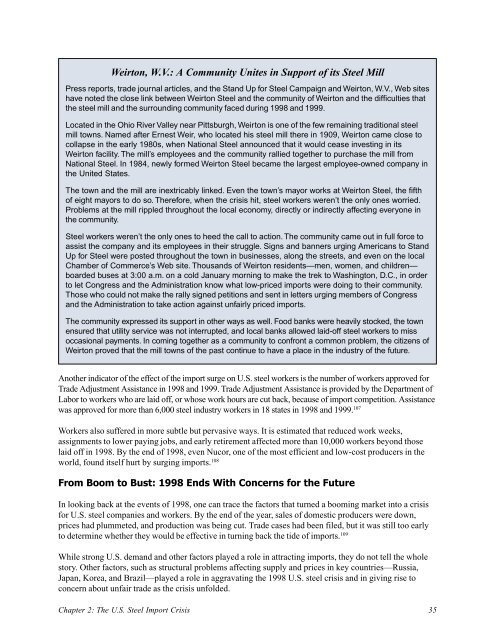Global Steel Trade; Structural Problems and Future Solutions
Global Steel Trade; Structural Problems and Future Solutions
Global Steel Trade; Structural Problems and Future Solutions
Create successful ePaper yourself
Turn your PDF publications into a flip-book with our unique Google optimized e-Paper software.
Weirton, W.V.: A Community Unites in Support of its <strong>Steel</strong> Mill<br />
Press reports, trade journal articles, <strong>and</strong> the St<strong>and</strong> Up for <strong>Steel</strong> Campaign <strong>and</strong> Weirton, W.V., Web sites<br />
have noted the close link between Weirton <strong>Steel</strong> <strong>and</strong> the community of Weirton <strong>and</strong> the difficulties that<br />
the steel mill <strong>and</strong> the surrounding community faced during 1998 <strong>and</strong> 1999.<br />
Located in the Ohio River Valley near Pittsburgh, Weirton is one of the few remaining traditional steel<br />
mill towns. Named after Ernest Weir, who located his steel mill there in 1909, Weirton came close to<br />
collapse in the early 1980s, when National <strong>Steel</strong> announced that it would cease investing in its<br />
Weirton facility. The mill’s employees <strong>and</strong> the community rallied together to purchase the mill from<br />
National <strong>Steel</strong>. In 1984, newly formed Weirton <strong>Steel</strong> became the largest employee-owned company in<br />
the United States.<br />
The town <strong>and</strong> the mill are inextricably linked. Even the town’s mayor works at Weirton <strong>Steel</strong>, the fifth<br />
of eight mayors to do so. Therefore, when the crisis hit, steel workers weren’t the only ones worried.<br />
<strong>Problems</strong> at the mill rippled throughout the local economy, directly or indirectly affecting everyone in<br />
the community.<br />
<strong>Steel</strong> workers weren’t the only ones to heed the call to action. The community came out in full force to<br />
assist the company <strong>and</strong> its employees in their struggle. Signs <strong>and</strong> banners urging Americans to St<strong>and</strong><br />
Up for <strong>Steel</strong> were posted throughout the town in businesses, along the streets, <strong>and</strong> even on the local<br />
Chamber of Commerce’s Web site. Thous<strong>and</strong>s of Weirton residents—men, women, <strong>and</strong> children—<br />
boarded buses at 3:00 a.m. on a cold January morning to make the trek to Washington, D.C., in order<br />
to let Congress <strong>and</strong> the Administration know what low-priced imports were doing to their community.<br />
Those who could not make the rally signed petitions <strong>and</strong> sent in letters urging members of Congress<br />
<strong>and</strong> the Administration to take action against unfairly priced imports.<br />
The community expressed its support in other ways as well. Food banks were heavily stocked, the town<br />
ensured that utility service was not interrupted, <strong>and</strong> local banks allowed laid-off steel workers to miss<br />
occasional payments. In coming together as a community to confront a common problem, the citizens of<br />
Weirton proved that the mill towns of the past continue to have a place in the industry of the future.<br />
Another indicator of the effect of the import surge on U.S. steel workers is the number of workers approved for<br />
<strong>Trade</strong> Adjustment Assistance in 1998 <strong>and</strong> 1999. <strong>Trade</strong> Adjustment Assistance is provided by the Department of<br />
Labor to workers who are laid off, or whose work hours are cut back, because of import competition. Assistance<br />
was approved for more than 6,000 steel industry workers in 18 states in 1998 <strong>and</strong> 1999. 107<br />
Workers also suffered in more subtle but pervasive ways. It is estimated that reduced work weeks,<br />
assignments to lower paying jobs, <strong>and</strong> early retirement affected more than 10,000 workers beyond those<br />
laid off in 1998. By the end of 1998, even Nucor, one of the most efficient <strong>and</strong> low-cost producers in the<br />
world, found itself hurt by surging imports. 108<br />
From Boom to Bust: 1998 Ends With Concerns for the <strong>Future</strong><br />
In looking back at the events of 1998, one can trace the factors that turned a booming market into a crisis<br />
for U.S. steel companies <strong>and</strong> workers. By the end of the year, sales of domestic producers were down,<br />
prices had plummeted, <strong>and</strong> production was being cut. <strong>Trade</strong> cases had been filed, but it was still too early<br />
to determine whether they would be effective in turning back the tide of imports. 109<br />
While strong U.S. dem<strong>and</strong> <strong>and</strong> other factors played a role in attracting imports, they do not tell the whole<br />
story. Other factors, such as structural problems affecting supply <strong>and</strong> prices in key countries—Russia,<br />
Japan, Korea, <strong>and</strong> Brazil—played a role in aggravating the 1998 U.S. steel crisis <strong>and</strong> in giving rise to<br />
concern about unfair trade as the crisis unfolded.<br />
Chapter 2: The U.S. <strong>Steel</strong> Import Crisis 35
















